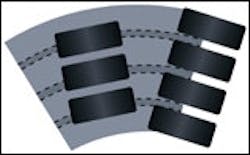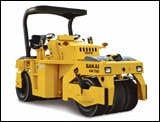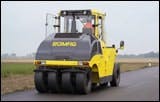New Asphalts Ache for Pneumatic Rollers
- Bomag
- Ingersoll Rand
- Hamm
- Sakai
- Leeboy
- Ingram
- Hypac
- Dynapac
- Calder Brothers
- Caterpillar
- Pneumatic-Roller Specs (by ballasted weight)
- Pneumatic-Roller Costs
Today's asphalt mixes and road designs are conspiring to make something of a hero out of the pneumatic-tire roller. The rubber-tired compactor is a specialized tool, making up less than 15 percent of all rollers working in the United States, according to the 2003 Construction Equipment Universe Study. Although there are little more than 10,000 of them at work here, and even many of their manufacturers consider the pneumatic-tired compactor to be less than glamorous, their role in highway paving is becoming crucial and choosing the right one for smaller work requires discernment.
Two rows of carefully spaced tires create a kneading action, helping the pneumatic roller achieve more consistent density from the bottom of a lift of material to the surface. The proliferation in highway designs of compaction specs enforced by agencies that drill and analyze road cores has heightened attention to the compaction applied to asphalt paving.
"Rubber-tired rollers tend to compact from the bottom up because of the way the load is transferred through the lift," says Jim Scherocman, a consulting engineer with 40 years of experience in asphalt paving. "It makes sense to use one in front of a tandem vibratory roller, for example, because tandem vibratories tend to compact from the top down."
The result is a uniformly compacted lift and test results that earn contractors completion bonuses.
The recipes used to brew various Superpave asphalt mixtures have created some challenges to achieving specified road densities. Some mixes are stiff and difficult to compact because they contain a sizeable dose of crushed fine aggregate. Some coarse-graded mixes are designed with aggregate gradations below the maximum density line. These become tender — meaning the mat moves or shoves under the compactive effort — within a narrow range of temperatures commonly measured in the fresh mat not far behind the screed.
High-frequency, double-drum vibratory rollers were developed to compact quickly, before the mat cools into the tender zone. But pneumatic rollers are best for overcoming a stiff mix's resistance to compaction. And the same kneading action that works well on stiff mixes has proven effective on tender mixes.
"Various mixes, due to their propensity for pushing and shoving, cannot be compacted at specific temperatures by conventional tandem rollers," says Steve Wilson, manager of product development at Bomag Americas. "Pneumatics, on the other hand, can effectively work into this 'tender zone' temperature area, thus improving the compaction process and production."
Scherocman says that feature is nearly essential on many highway-construction projects because time is not on your side.
"Most tender zones start at 240 degrees Fahrenheit and extend down to about 190 F, but it varies widely because of mix properties," he points out. "I was consulting on a job last year in Mississippi where the mats were starting to get tender at 280 F."
The asphalt was tender at the back of the screed. There was no window for breakdown compaction with a steel-drum roller.
Even when dealing with more normal tender zones, variations in mix temperature as it is paved can leave so little time for breakdown compaction before the mat becomes tender that a contractor has no choice but to rely on a pneumatic roller.
"For example, if mix is coming out the back of the paver at 300 F on a 40 F day and you're compacting a 3-inch lift, it takes 32 minutes for the mat surface to cool down to 175 F," says Scherocman. "But if the next load of mix is 250 F behind the screed, you only have 19 minutes before it reaches 175 F."
The mat will be tender for two-thirds of that time, leaving an all-steel roller spread less than 6½ precisely timed minutes to achieve maximum density.
Time available to achieve finished compaction is dramatically shorter if the road design calls for thinner lifts. For example, 300 F asphalt going down in a 2-inch lift on a 40 F day cools to 175 F in about 16 minutes. A load that comes out of the paver at 250 F will be too cool to compact in 10 minutes.
"You have three choices for compacting tender mixes," says Scherocman. "First, you can use a tandem-vibratory breakdown roller, a pneumatic as an intermediate roller, and a static finish roller. That works very, very well under a wide variety of conditions.
"Second, you can use two tandems, and not use a finish roller," Scherocman continues. "You will have to work the vibratories side-by-side or in echelon to take advantage of temperature of the mat right behind the paver. You're gambling that you can hit the specified density before the mat cools down into the tender zone, but as we saw, that depends largely on the temperature of the mix behind the screed.
"And the third choice is to use a tandem vibratory roller in front of the tender zone and a static finish roller after it . . . and pray that the mat is consistently hot behind the paver."
Variations in asphalt plants, volume of traffic, and the vagaries of equipment breakdowns defy all efforts to consistently deliver hot mix to the paver. That's why many new rollers come with mat-temperature gauges. It's a highly recommended feature for compacting Superpave designs because a read of mat-surface temperature and a knowledge of the mix tender zone and the cooling rate of the lift will tell the roller operator how much time is available to achieve density.
Concerns that a large pneumatic roller would not be able to keep up with its high-frequency, tandem vibratory rollers inspired Sakai to add the fast-compacting power of vibration to a pneumatic's kneading action. Last year the company introduced the seven-wheeled GW750 — what continues to be the world's only vibratory pneumatic roller. A pair of eccentric shafts in each axle vibrates a specially designed set of tires. The GW750 is a 20,600-pound roller that, according to Sakai, can compact at the top of its four amplitude modes with the force of a 55,000-pound machine.
GraniteRock's Pavex division in Northern California tested and then bought the GW750 prototype in 2004. The company also bought the second machine Sakai brought to North America. The company reports bonus-winning results with the unique machines. After working out the proper release agents to use on various high-spec mixes, the company has had great success using them on everything from parking lot and cul-de-sac paving to highway and airport work.
An issue that's important to success when using a pneumatic roller is that of mat coverage when the machine is turning. Coverage in sharp turns is an issue that becomes more critical on smaller projects such as parking lots and streets, where there are more turns to pave. When the front wheels of a pneumatic roller steer, the rear wheels may not completely overlap the space between their paths, resulting in variations in density under those areas. Some smaller rollers, such as Sakai's GW750, Bomag's BW11RH and Hypac's C530AH, Ingram's AP915 and the Rosco Tru-Pac 915 are articulated like a wheel loader to ensure that wheel overlap doesn't change.
"A straight-frame roller (not articulated) will generally be less expensive. However, it will also not provide the many benefits of articulation," says Steve Simons, communications manager with LeeBoy. "On a straight roadway chip-seal job, a faster roller for continuous back and forth motion will be efficient. For chip-seal jobs with many turns, such as parking lots or cul de sacs, articulation will be more efficient and effective."
Hydrostatic transmissions have come on strong as that technology has proven its performance and durability under heavy loads. Eliminating gear shifts removes a point at which the roller might mark the mat (a valuable feature on projects that pay bonuses based on profilograph ride-smoothness measurements) and hydrostatic drive facilitates infinite control of the smooth transition from reverse to forward and back. Today's powershift transmissions can shift quite smoothly, but roller applications seem to favor hydrostats.
All pneumatic rollers under 46,000 pounds have hydrostatic drive. Of the 14 models over 46,000 pounds ballasted weight, six have powershift transmissions. Bomag, Caterpillar, Ferguson and Ingram make hydrostats heavier than 46,000 pounds, and the heaviest rubber-tired rollers available — Ferguson's SP-1130 and Ingram's RP930 — are hydrostats.
"Higher production, relating to increased profit, has always been an issue," says Bomag's Wilson. "This has driven the industry to faster, smoother rollers and the transition to fully hydrostatic drive versus gear-train-propelled rollers."
Pneumatic rollers have long been used along with other asphalt rollers. Their inability to deliver a finished road surface relegated rubber-tired rollers to the role of niche tools. But the development of specialized tires has equipped rubber-tired compactors to do some finish rolling as well.
"We have been impressed in some areas with the pneumatic's ability to be used as a finish roller," says Wilson. "This is accomplished by the utilization of a 'flat-profile,' or more square-shoulder tire. This design tire, though not totally eliminating tire marking, greatly reduces it."
As mixes, road designs and equipment technologies advance, it makes good business sense to look at how pneumatic-tired rollers might solve some problems in new ways.



